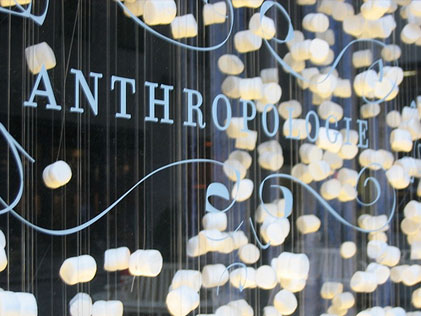We really clicked on Tuesday.
Katy, our designer, rocked. Thank you so much!
Caroline was our Anthro expert and Ashling made the team’s ideas a reality. Steve, Pablo, and I filled in the gaps.
I really don’t know what else to say… Pablo and Ashling already nailed our story with great images I won’t reproduce.
Well I’ll just say that we didn’t really think about team dynamics or really much about time. We were definitely under a time crunch, but it didn’t feel stressful or bad. We went to the store, got what we needed. Put the store into words. We talked strategy (Anthropologie’s logo is already really well designed so we just wanted to add to it, not replace it). We started prototyping as a group. We quickly reached consensus on a general idea. Half the group (the girls) polished the logo up the rest of the way and the boys practiced the pitch. We hit print and bam we were done.
I’m really happy with our end result and I’m not sure I’ve ever had such a smooth and coherent team exercise. I think the concepts of this class are really becoming ingrained in each of us…which is amazing.
BUT…I do wonder how one of us would walk into a group of total strangers who haven’t taken this class and get the same results. It’s one thing to learn how to unlock your own creativity. But I want to know how to help others unlock their own creativity…in a time crunch.



Bingo Andrew! Bravo, on your performance and outcome of DP2. The question you asked about how to bring this “type of thinking/process” to an untrained group of people is something I too am trying to figure out. Both my ME310 and Biodesign team had no background in this type of culture. Therefore my introduction and teaching to the process was a conglomeration, trial an error of:
– going out to eat to get to know each other
– asking them a lot of questions of why they think that way, or asking where are they coming from
– introducing them to my brainstorming video, have them try it out, showing off my brainstorming techniques and letting them experience how I can actually accelerate and add a lot more to the brainstorming process
– just going out and doing more need finding on my own when my other teammates really didn’t want to or see the point
– call them on the phone (versus emails) for debriefs, reflections, check-ins
– draw cartoons for my teammates to illustrate how we can improve our process
– tell them stories of my past projects, what worked and what didn’t work
I do all sorts of things to sell, demonstrate or explain the design process. Good luck Andrew. Keep me posted!
To sum it up, being creative about the “collaboration process” is key, creating a culture where these “strangers” to the design process learn to embrace it is very, very difficult.
It’s definitely challenging, especially when accomplishing a task is the goal (not learning about creativity). I think it’s all about creating the right environment at the right time. Encourage the group to be creative, not judgmental when you’re brainstorming. Encourage the group to be decisive when it’s time to move on. There are a lot of tools to help do this (warm-ups, questioning assumptions, 6 hats…etc). But it’s easier said than done and it can be very challenging to do without assigning yourself as the group’s leader….
Thanks for the response. We can talk more over coffee or food. Cheers!